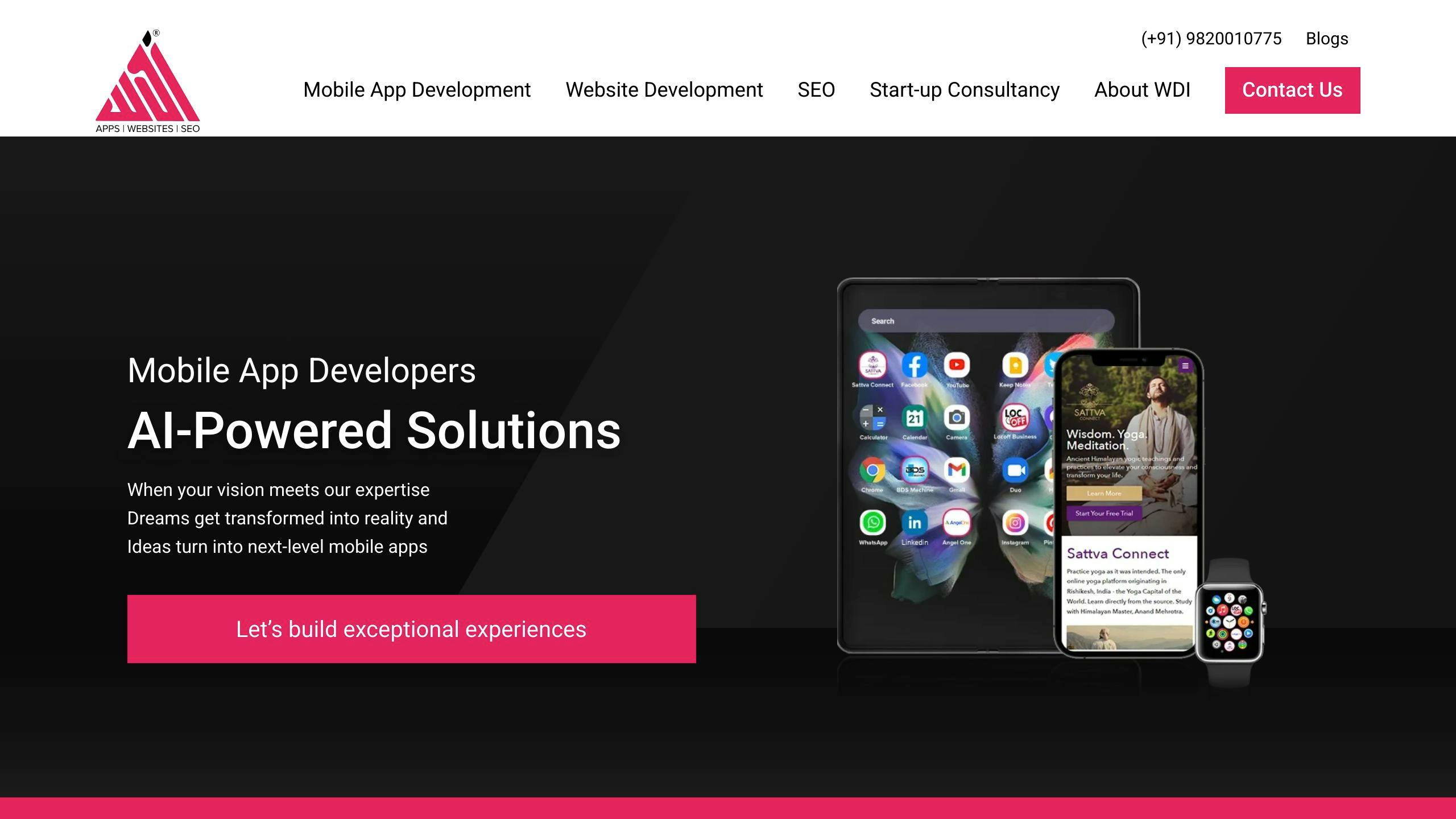Developing mobile apps comes with a set of challenges that developers need to navigate to meet user expectations. Here’s what you need to know in simple terms:
- Understanding User Expectations: Mobile users demand personalized experiences, intuitive UI/UX, robust security, and privacy. Meeting these expectations is crucial for app success.
- Evolving User Expectations: User wants change over time, influenced by new technologies and trends. Continuous market research and user feedback are vital.
- Security and Privacy Concerns: Protecting user data against breaches is paramount. Encryption, regular security checks, and clear data use policies are essential.
- Seamless User Experience Across Devices: Apps must offer a consistent experience on different devices and screen sizes, which requires responsive design and extensive testing.
- Integration with Emerging Technologies: Incorporating technologies like AI and AR/VR presents challenges due to their evolving nature but can set an app apart.
- Continuous Updates and Compatibility: Keeping up with OS updates and new devices is necessary to avoid app obsolescence.
Working with a seasoned mobile app development company can help navigate these challenges effectively, leveraging their expertise across platforms and devices, focusing on user experience, and employing the latest technologies. The goal is to stay ahead by continuously improving the app in response to user feedback and technological advancements.
Personalized Experiences
Users like apps that know what they want. To do this, app makers can:
- Use smart suggestions to show users things they might like
- Let users set up alerts that matter to them
- Keep track of how users interact with the app to offer more of what they like
Putting in the extra work to make these things happen can make users more likely to stick around.
Intuitive UI/UX
The app should be easy to use and look good. This means:
- Keeping the design simple and familiar
- Making sure the app looks and works the same on all devices
- Organizing information so it’s easy to find
- Helping users with tips when they need it
Finding out what works best involves asking users, looking at data, and testing different ideas.
Security
Users want to know their personal information is safe. This means:
- Keeping data secure when it’s sent or stored
- Using passwords or fingerprints to check who’s using the app
- Checking the app for security problems and fixing them fast
- Being ready to fix any security issues that come up
Gaining users' trust by keeping their data safe is crucial.
Privacy
Users want to feel in control of their information. App makers can help by:
- Being clear about what data they’re collecting and why
- Letting users choose what information they share
- Explaining how data is used
- Making it easy for users to say no to data collection
Respecting users' privacy makes them more likely to use the app happily.
Understanding what users expect helps app makers create apps that people enjoy using. Keeping up with what users like and don’t like by asking them and looking at how they use the app is important. This way, app developers can keep improving the app and keep users interested.
Challenge 1: Evolving User Expectations
Problem
It's tough for those who make apps to keep up with what users want because these wants keep changing. As new technology comes out and what people like changes, developers have to make sure their apps stay up-to-date. If they don't, users get upset, and they might stop using the app.
Here are a few reasons why keeping up is hard:
- Frequent platform updates - Systems like iOS and Android often bring out big updates. Developers have to make sure their apps work with these changes and use any new features.
- Competitive innovation - The world of apps is always changing. Other apps might add cool new features, and then users start expecting these from all apps.
- Changing user habits - How people use their phones changes a lot. For example, more people like using messages and stories now, so they want apps to offer similar things.
All of this means that what users want from apps keeps changing. If developers only focus on what users want right now, their apps will quickly feel old.
Solution
To keep up with what users want, developers need to constantly watch and react to these changes.
Conduct ongoing market research
- Ask users what they think and what they want more of
- Look at app store reviews and online comments to find out what users don't like
- Keep an eye on what other apps are doing
Build in feedback mechanisms
- Add ways for users to tell you what they think, like polls or ratings inside the app
- Talk to groups of users to get deeper insights
- Make it easy for users to send feedback
Take an iterative approach
- Update the app often to try out and improve new features
- Start with a basic version of new features to see how users react, then make them better
- Use a design that lets you easily change parts of the app
This mix of keeping an eye on the market, listening to users, and making frequent updates will help make sure your app stays interesting. As what users want changes, you'll be ready to update your app to match. This way, you're always ahead, not just trying to catch up.
Challenge 2: Security and Privacy Concerns
Problem
When mobile apps gather lots of user info, people start worrying more about hackers and their privacy. Developers need to make sure they protect this data well to keep users' trust. If they don't, bad things can happen like:
- People could have their money or identity stolen
- Important personal details might be lost forever
- If there's a data leak, it could scare away users and look really bad
- Not following the rules could mean big fines and legal trouble
Users also want to know how their info is used by apps. If developers don't make this clear and ask users' permission, they could upset a lot of people.
Solution
To keep data safe and respect users' privacy, developers should:
Use encryption and check who's logging in
- Make sure data sent or stored can't be read by others by using encryption
- Check who's using the app with passwords or fingerprints
- Change encryption keys often to keep things secure
Check for security risks often
- Always watch for any strange activity in the system or with data
- Review the app's code to find possible weak spots
- Test the app to find any security issues
Be clear about data use and ask for permission
- Tell users exactly how their data will be used
- Let users say no to data collection and delete their info
- Always get a clear yes before gathering sensitive data
Have a plan for when things go wrong
- Be ready with a quick way to find, stop, and tell users about any data leaks
- Know how to fix the problem, get data back, and stop it from happening again
Making sure security and privacy are top priorities from the start is the best way to build trust with users and avoid big problems with data.
Challenge 3: Ensuring a Seamless User Experience Across Devices
Problem
Making a mobile app that looks and works great on all kinds of devices, like phones and tablets of different sizes, is really hard. People expect to use an app on their phone one minute and on their tablet the next without any issues.
Here's why this is tough:
- Varying screen dimensions - Phones come in all sorts of sizes now. Creating an app that looks good on both small and big screens isn't easy.
- Different device capabilities - Devices like tablets, phones, and even smartwatches all do different things. Making an app that works well on all of them can get pretty complicated.
- Cross-platform support - People want to use their app on both iOS and Android devices without missing out on anything. It's hard to make sure the app works the same on both.
If an app wasn't made to adapt to different screens from the beginning, fixing it later can be really hard. This can make users unhappy if they expect their apps to work perfectly on any device.
Solution
To fix this problem, developers should:
Prioritize responsive design
- Make layouts that adjust to any screen size
- Ensure text, buttons, and other parts change size smoothly
- Design screens to be easy to use with touch, not just with a mouse or keyboard
Design for the smallest screen first
- Start with making the app work on phones before thinking about bigger screens
- As you move to larger devices, add more content instead of taking things away
Conduct extensive cross-device testing
- Test the app on lots of different devices while it's being made
- Fix any problems that show up on certain devices
- Try to make sure the app can do the same things across all devices and platforms
Enable seamless state syncing
- Use online storage so users can switch devices without losing their place
- Make sure users can pick up where they left off, even on a different device
- Keep users logged in and remember their settings across devices
Starting with a design that works on any device and testing a lot during development can help solve this problem. It means more work at the beginning but results in users being happier because they can use the app easily on any device.
Challenge 4: Integration with Emerging Technologies
Problem
Adding new tech like AI, AR/VR, into mobile apps is tough. These technologies are always changing, making it hard for developers to keep up.
Here’s what makes it difficult:
- Quickly changing APIs and SDKs - The tools developers use to add new tech into apps change a lot, causing lots of rework.
- Lack of stability and maturity - New tech often has problems like bugs or missing features.
- High development costs - Using advanced tech needs special skills and lots of testing, which costs more.
- Questions around user adoption - It’s not always clear if people will like or understand the new tech.
With all these changes and unknowns, it’s hard for developers to add the latest tech into apps. If they don’t, though, their app might seem old-fashioned.
Solution
Instead of guessing which new tech will work out, developers should take small steps:
Start with minimum viable products (MVPs)
- Try out small parts of the new tech first
- Use these tests to see how people react
- Be ready to remove these parts if they don’t work out
Work closely with tech partners
- Join forces with companies that make the new tech
- Get help to fix problems quickly
- Share your thoughts to help improve their products
Analyze user feedback and behavior
- Use data to see how people use the new features
- Ask users for their opinions
- Look for signs that the new tech isn’t useful to them
Improve integrations gradually
- Use what you learn to make the new tech better
- As the tech gets more stable, add more features
- Slowly build up to more complete and polished experiences
This careful approach lets mobile developers add new tech without feeling overwhelmed. By starting with small tests and learning as they go, they can make the new tech better over time.
sbb-itb-8abf120
Challenge 5: Keeping Up with Continuous Updates and Compatibility
Problem
Making sure a mobile app works well with the newest operating systems (like iOS and Android) and devices is a big task. Every time a new version of an operating system or a new device comes out, developers have to update their apps. But things change so fast, it's hard to keep up.
Here's what makes it tough:
- Frequent OS updates - iOS and Android often release new versions, sometimes more than once a year. These updates can change things and cause apps to break.
- Variations in devices - Every year, new iPhones and Android devices come out, leading to thousands of different combinations of hardware. Making an app work well on all these different setups is really hard.
- Short update timelines - Apple and Google don't give developers much time to get their apps ready for new updates. If apps aren't updated in time, they could be removed from app stores.
- Development bottlenecks - Keeping up with updates requires a lot of coordination between developers, testers, and those who release the apps. When updates keep coming, it's easy for these teams to get bogged down.
If developers don't regularly update their apps to work with new OS versions and devices, the apps can start having problems, which frustrates users and can lead to the apps being taken off app stores.
Solution
To manage constant updates, developers should be flexible and prepared:
Set up a dedicated compatibility team
- Have a special team that focuses only on making sure the app works with new updates and devices.
Build basic compatibility early
- From the beginning, make your app in a way that it can easily adjust to new operating systems.
- Use a design that makes it simple to update the app.
Test on beta OS versions
- Try your app on early versions of new operating systems.
- Find and fix any issues before everyone else starts using the new version.
Automate testing across devices
- Use tools that let you quickly check how your app works on many different devices.
- Find bugs that might not be obvious right away.
Plan update timelines around releases
- Keep track of when new operating systems and devices are coming out.
- Schedule your updates based on these dates to make sure your app is always ready.
By staying organized and ready for changes, developers can make sure their apps keep working well, no matter what new updates come out. This keeps users happy and the app in good standing.
Implementing Solutions: Partnering with a Mobile App Development Company

Working with a company that knows a lot about making mobile apps can help solve many of the problems we've talked about. A company like Zee Palm can be really helpful because:
Expertise Across Platforms and Devices
Zee Palm has been making apps for iOS, Android, and the web for over 20 years. They know all about the latest updates, different devices, and how to make sure an app works well no matter where it's used.
Focus on User Experience
Zee Palm always checks in with users to see what they like and what could be better. They use this info to make quick updates, making sure their apps are easy and fun to use.
End-to-End Services
Zee Palm takes care of everything:
- Figuring out what you need
- Sketching out the app's design
- Making the app look good
- Building and testing the app
- Getting the app ready to launch
- Helping out after the app is out there
They walk you through each step, making sure you always know what's going on.
Use of New Technologies
Zee Palm uses the latest tech to build apps. This means they can add cool features using AI, AR, or blockchain, making your app stand out.
Affordable Pricing
Zee Palm has different pricing plans that can fit any budget. This makes it possible for even new businesses to get a custom app without spending too much.
By working with Zee Palm, you can get past the tough parts of making a mobile app and end up with something users will really enjoy. They make the whole process easier, so you can focus on your business.
Conclusion
Staying Ahead of Evolving User Expectations
Making sure your app keeps up with what users want and need is really important but can be tough. This article has shown that the world of apps is always changing, and developers need to keep their apps up to date, easy to use, and full of the features people want.
But, there are ways to handle these challenges:
- Conduct ongoing market research to keep an eye on what users like and don’t like.
- Build in feedback channels so you can hear directly from users about what works and what doesn’t.
- Take an iterative approach by constantly updating your app with improvements and new stuff.
- Prioritize security and privacy by protecting user data and being clear about how it’s used.
- Design for consistency so your app works well on all devices, whether it’s an iPhone or an Android tablet.
- Gradually integrate emerging technologies by testing out new features in small steps.
- Create robust compatibility practices to make sure your app works with the latest updates of iOS and Android.
Working with a company that knows a lot about making apps, like Zee Palm, can also help a lot. They’re experts in making apps for different platforms, they focus on what users want, they cover everything from planning to launching your app, they use the latest tech, and they have pricing that works for different budgets.
In the end, the companies that do well in the app world are the ones that are always ready for change, listen to their users, and keep making their apps better. With the right approach and help, developers can stay on top of what users want and keep their apps popular. The world of mobile apps is always moving, but if you focus on your users and keep improving, your app can stay ahead.
Related Questions
What are the common problems encountered in mobile application development?
When making mobile apps, some usual troubles include:
- Not knowing who will use the app and what they need
- Teams not talking well enough with each other or with the people they're making the app for
- Apps not working well on all phones and tablets
- Not planning properly for what the app should do, how long it will take, and how much it will cost
- Worrying about keeping the app and user information safe
To dodge these issues, teams should really understand who will use the app and what they want, talk clearly with everyone involved, test the app on many devices, plan carefully, and always think about security first.
Which one is the challenge of mobile application development?
A big challenge is making sure the app works on lots of different phones and tablets. It's tricky because iOS (like iPhones) and Android phones and tablets all have screens that look different. Developers have to make sure the app looks good and works well no matter the screen size or device type.
Testing a lot on actual devices and using design tricks that make the app adjust to any screen size are important. Starting with a mobile-first design can also help manage this challenge.
What are the weaknesses of mobile app development?
Weak points in making mobile apps include:
- It can cost a lot and take a lot of work
- Apps need regular updates and care
- There are costs to put apps on app stores
- It can be hard to make money from the app
- There are risks of hackers and privacy leaks
- The app needs people to download and keep using it
Making an app takes a big investment, and to be successful in the long run, the app must be really useful and well-made.
Why mobile app development is difficult?
Making apps is especially hard because there are so many different phones and tablets out there. This is called device fragmentation. For example, Android phones and tablets come in all shapes and sizes, and even iPhones have different screen sizes.
Developers have to think about:
- Different screen sizes and qualities
- Different hardware like processors and cameras
- Different versions of the operating systems
- How people use their phones and tablets
- Making sure the app works well on both cheaper and more expensive devices
Handling all these differences during making and testing the app is important for a good app experience.












